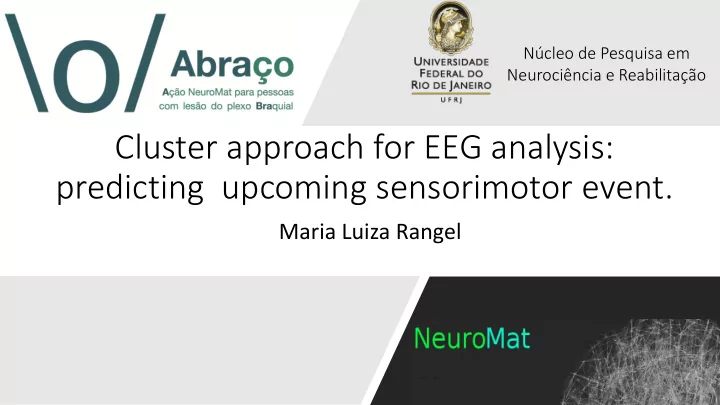

Núcleo de Pesquisa em Neurociência e Reabilitação Cluster approach for EEG analysis: predicting upcoming sensorimotor event. Maria Luiza Rangel
Prediction investigation The ability to predict an upcoming action is an intrinsic property of the motor system. Brachial Plexus Injury (BPI) leads to severe impairment of upper limb function . Is it possible that sensory and motor deficits associated with BPI affects prediction? Would the sensorimotor cortex be able to distinguish between prediction contexts? Does BPI affect prediction ability?
Hand Mov Action observation paradigm Ball Mov No Mov Experimental setup
Protocol • Duration: ~ 2h • 6 blocks (3 right hand and 3 left hand) • 60 trials per block • Conditions presented at random
Protocol Readiness Potential – Prediction marker (Kilner et al, 2004) Time window - Negative slope 500 ms before movemet beggining
Participants • Control Group 18 participants --- 9 included in the analyses after signal examination and pre- processing 7 males, mean age 29,9 years, Right handed • Brachial Plexus Injury Group 9 participants, 6 included, all male, mean age 28,6 years, Right Handed
P01
Classical Readiness Potential
3 steps 1)K-means cluster analysis 2)Fisher exact-test 3)Multi-subject analysis
Data preparation For each subject we consider two sets of electrodes: 8 electrodes in the sensorimotor cortex (in red), and 8 control electrodes over temporal cortex ( in blue). For each subject and each electrode (ex. CP3) we compute the average signal across epochs for each experimental condition
Data preparation Second, we consider the 12 averaged signals, obtained from the three experimental conditions for all 4 electrodes of the sensorimotor cortex For each subject, the 12 averaged signals for the electrodes in the sensorimotor cortex and the control electrodes were submitted to an hierarchical analysis, the first step was a k-means cluster analysis.
+ 1) K-means cluster analyses + + 2ª Iteração 1ª Iteração For each subject and set of electrodes, the goal was to group the 12 curves (3 conditions x 4 electrodes) into 3 possible clusters: A, B or C. If the signal in the sensorimotor cortex is different between conditions, the signals from the same condition should belong to the same cluster , with a high separation between the clusters. Our hypothesis is that we are able to observe this separation between conditions in the sensorimotor cortex but not in the set of temporal electrodes
K-means cluster analyses Illustration of how the k-means cluster assigns a label to each one of the 12 averaged signals Signal 1 2 3 4 5 6 7 8 9 10 11 12 Cluster A A A A B B B B C C C C After the k-means step, we have a contingency table for each subject and for both sets of electrodes. Cluster A Cluster B Cluster C Hand Mov 4 0 0 Ball Mov 0 4 0 Intuitively, we can say that if the signals in 2 different conditions belong to the same cluster, we have an indication that the brain is not recognizing the conditions as distinct from each other.
2) Fisher exact-test H0 : The cluster label is independent of the experimental condition H1 : The cluster label is not independent of the experimental condition Is there a strong dependence between condition and cluster label? 3) Multi-subject analysis The Fisher's exact test is performed for each subject independently. Therefore, 12 tests are performed. The Benjamini – Hochberg procedure was performed for correcting the p- value and controlling the false positive rate in multiple comparisons.
Results Control Group (N=9) Right Hand Observation Temporal cortex Sensorimotor cortex electrodes electrodes (control) Condition comparison Right Left Right Left Hemisphere Hemisphere Hemisphere Hemisphere Ball Mov x No Mov 9 7 0 0 Hand Mov x No Mov 8 8 0 0 Hand Mov x Ball Mov 7 8 0 0 The table indicates the number of subjects that rejected H0
Results Control Group (N=9) Left Hand Observation Temporal cortex Sensorimotor cortex electrodes (control) electrodes Condition comparison Right Left Right Left Hemisphere Hemisphere Hemisphere Hemisphere Ball Mov x No Mov 9 9 0 0 Hand Mov x No Mov 8 8 0 0 Hand Mov x Ball Mov 9 6 0 0 The table indicates the number of subjects that rejected H0
Results Brachial plexus Injury(N=6) – Right Hand Observation Temporal cortex Sensorimotor cortex electrodes (control) electrodes Right Left Condition comparison Right Left Hemisphere Hemisphere Hemisphere Hemisphere 0 0 Ball Mov x No Mov 4 0 0 0 Hand Mov x No Mov 0 4 Hand Mov x Ball Mov 0 5 0 0 The table indicates the number of subjects that rejected H0
Results Brachial plexus Injury(N=6) Left Hand Observation Temporal cortex Sensorimotor cortex electrodes (control) electrodes Condition comparison Right Left Right Left Hemisphere Hemisphere Hemisphere Hemisphere Ball Mov x No Mov 4 5 0 0 Hand Mov x No Mov 0 0 0 0 Hand Mov x Ball Mov 0 0 0 0 The table indicates the number of subjects that rejected H0
Recommend
More recommend